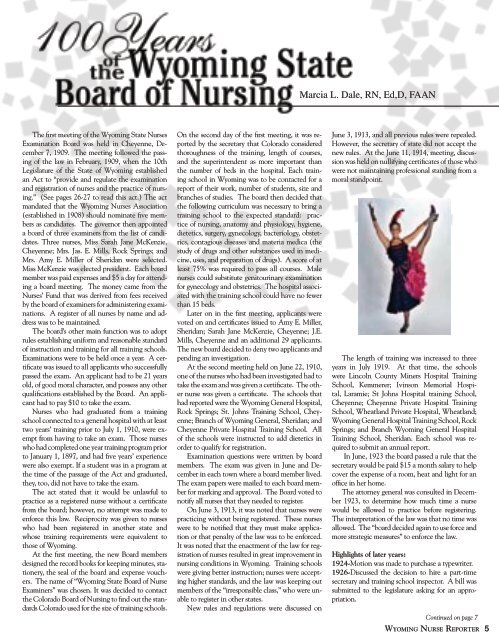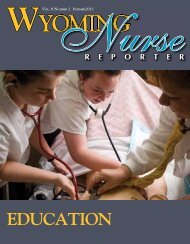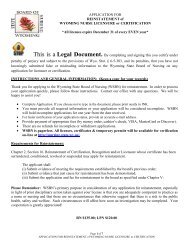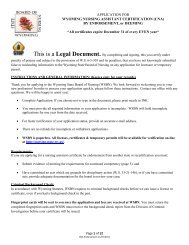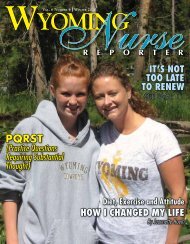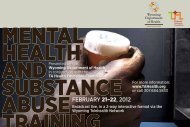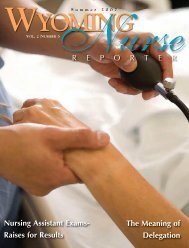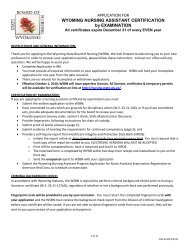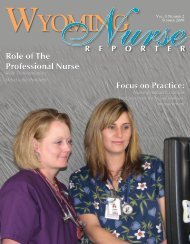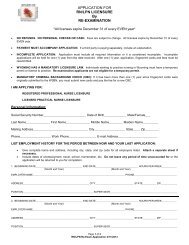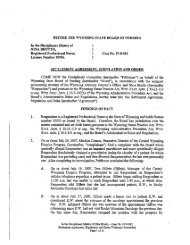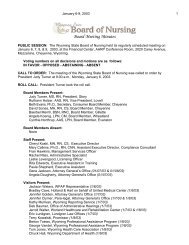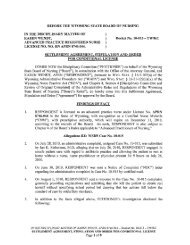Nurse Reporter Spring 2009 - Wyoming State Board of Nursing
Nurse Reporter Spring 2009 - Wyoming State Board of Nursing
Nurse Reporter Spring 2009 - Wyoming State Board of Nursing
Create successful ePaper yourself
Turn your PDF publications into a flip-book with our unique Google optimized e-Paper software.
Marcia L. Dale, RN, Ed,D, FAAN<br />
The first meeting <strong>of</strong> the <strong>Wyoming</strong> <strong>State</strong> <strong>Nurse</strong>s<br />
Examination <strong>Board</strong> was held in Cheyenne, December<br />
7, 1909. The meeting followed the passing<br />
<strong>of</strong> the law in February, 1909, when the 10th<br />
Legislature <strong>of</strong> the <strong>State</strong> <strong>of</strong> <strong>Wyoming</strong> established<br />
an Act to “provide and regulate the examination<br />
and registration <strong>of</strong> nurses and the practice <strong>of</strong> nursing.”<br />
(See pages 26-27 to read this act.) The act<br />
mandated that the <strong>Wyoming</strong> <strong>Nurse</strong>s Association<br />
(established in 1908) should nominate five members<br />
as candidates. The governor then appointed<br />
a board <strong>of</strong> three examiners from the list <strong>of</strong> candidates.<br />
Three nurses, Miss Sarah Jane McKenzie,<br />
Cheyenne; Mrs. Jas. E. Mills, Rock <strong>Spring</strong>s; and<br />
Mrs. Amy E. Miller <strong>of</strong> Sheridan were selected.<br />
Miss McKenzie was elected president. Each board<br />
member was paid expenses and $5 a day for attending<br />
a board meeting. The money came from the<br />
<strong>Nurse</strong>s’ Fund that was derived from fees received<br />
by the board <strong>of</strong> examiners for administering examinations.<br />
A register <strong>of</strong> all nurses by name and address<br />
was to be maintained.<br />
The board’s other main function was to adopt<br />
rules establishing uniform and reasonable standard<br />
<strong>of</strong> instruction and training for all training schools.<br />
Examinations were to be held once a year. A certificate<br />
was issued to all applicants who successfully<br />
passed the exam. An applicant had to be 21 years<br />
old, <strong>of</strong> good moral character, and possess any other<br />
qualifications established by the <strong>Board</strong>. An applicant<br />
had to pay $10 to take the exam.<br />
<strong>Nurse</strong>s who had graduated from a training<br />
school connected to a general hospital with at least<br />
two years’ training prior to July 1, 1910, were exempt<br />
from having to take an exam. Those nurses<br />
who had completed one year training program prior<br />
to January 1, 1897, and had five years’ experience<br />
were also exempt. If a student was in a program at<br />
the time <strong>of</strong> the passage <strong>of</strong> the Act and graduated,<br />
they, too, did not have to take the exam.<br />
The act stated that it would be unlawful to<br />
practice as a registered nurse without a certificate<br />
from the board; however, no attempt was made to<br />
enforce this law. Reciprocity was given to nurses<br />
who had been registered in another state and<br />
whose training requirements were equivalent to<br />
those <strong>of</strong> <strong>Wyoming</strong>.<br />
At the first meeting, the new <strong>Board</strong> members<br />
designed the record books for keeping minutes, stationery,<br />
the seal <strong>of</strong> the board and expense vouchers.<br />
The name <strong>of</strong> “<strong>Wyoming</strong> <strong>State</strong> <strong>Board</strong> <strong>of</strong> <strong>Nurse</strong><br />
Examiners” was chosen. It was decided to contact<br />
the Colorado <strong>Board</strong> <strong>of</strong> <strong>Nursing</strong> to find out the standards<br />
Colorado used for the size <strong>of</strong> training schools.<br />
On the second day <strong>of</strong> the first meeting, it was reported<br />
by the secretary that Colorado considered<br />
thoroughness <strong>of</strong> the training, length <strong>of</strong> courses,<br />
and the superintendent as more important than<br />
the number <strong>of</strong> beds in the hospital. Each training<br />
school in <strong>Wyoming</strong> was to be contacted for a<br />
report <strong>of</strong> their work, number <strong>of</strong> students, size and<br />
branches <strong>of</strong> studies. The board then decided that<br />
the following curriculum was necessary to bring a<br />
training school to the expected standard: practice<br />
<strong>of</strong> nursing, anatomy and physiology, hygiene,<br />
dietetics, surgery, gynecology, bacteriology, obstetrics,<br />
contagious diseases and materia medica (the<br />
study <strong>of</strong> drugs and other substances used in medicine,<br />
uses, and preparation <strong>of</strong> drugs). A score <strong>of</strong> at<br />
least 75% was required to pass all courses. Male<br />
nurses could substitute genitourinary examination<br />
for gynecology and obstetrics. The hospital associated<br />
with the training school could have no fewer<br />
than 15 beds.<br />
Later on in the first meeting, applicants were<br />
voted on and certificates issued to Amy E. Miller,<br />
Sheridan; Sarah Jane McKenzie, Cheyenne; J.E.<br />
Mills, Cheyenne and an additional 29 applicants.<br />
The new board decided to deny two applicants and<br />
pending an investigation.<br />
At the second meeting held on June 22, 1910,<br />
one <strong>of</strong> the nurses who had been investigated had to<br />
take the exam and was given a certificate. The other<br />
nurse was given a certificate. The schools that<br />
had reported were the <strong>Wyoming</strong> General Hospital,<br />
Rock <strong>Spring</strong>s; St. Johns Training School, Cheyenne;<br />
Branch <strong>of</strong> <strong>Wyoming</strong> General, Sheridan; and<br />
Cheyenne Private Hospital Training School. All<br />
<strong>of</strong> the schools were instructed to add dietetics in<br />
order to qualify for registration.<br />
Examination questions were written by board<br />
members. The exam was given in June and December<br />
in each town where a board member lived.<br />
The exam papers were mailed to each board member<br />
for marking and approval. The <strong>Board</strong> voted to<br />
notify all nurses that they needed to register.<br />
On June 3, 1913, it was noted that nurses were<br />
practicing without being registered. These nurses<br />
were to be notified that they must make application<br />
or that penalty <strong>of</strong> the law was to be enforced.<br />
It was noted that the enactment <strong>of</strong> the law for registration<br />
<strong>of</strong> nurses resulted in great improvement in<br />
nursing conditions in <strong>Wyoming</strong>. Training schools<br />
were giving better instruction; nurses were accepting<br />
higher standards, and the law was keeping out<br />
members <strong>of</strong> the “irresponsible class,” who were unable<br />
to register in other states.<br />
New rules and regulations were discussed on<br />
June 3, 1913, and all previous rules were repealed.<br />
However, the secretary <strong>of</strong> state did not accept the<br />
new rules. At the June 11, 1914, meeting, discussion<br />
was held on nullifying certificates <strong>of</strong> those who<br />
were not maintaining pr<strong>of</strong>essional standing from a<br />
moral standpoint.<br />
The length <strong>of</strong> training was increased to three<br />
years in July 1919. At that time, the schools<br />
were Lincoln County Miners Hospital Training<br />
School, Kemmerer; Ivinson Memorial Hospital,<br />
Laramie; St Johns Hospital training School,<br />
Cheyenne; Cheyenne Private Hospital Training<br />
School, Wheatland Private Hospital, Wheatland;<br />
<strong>Wyoming</strong> General Hospital Training School, Rock<br />
<strong>Spring</strong>s; and Branch <strong>Wyoming</strong> General Hospital<br />
Training School, Sheridan. Each school was required<br />
to submit an annual report.<br />
In June, 1923 the board passed a rule that the<br />
secretary would be paid $15 a month salary to help<br />
cover the expense <strong>of</strong> a room, heat and light for an<br />
<strong>of</strong>fice in her home.<br />
The attorney general was consulted in December<br />
1923, to determine how much time a nurse<br />
would be allowed to practice before registering.<br />
The interpretation <strong>of</strong> the law was that no time was<br />
allowed. The “board decided again to use force and<br />
more strategic measures” to enforce the law.<br />
Highlights <strong>of</strong> later years:<br />
1924-Motion was made to purchase a typewriter.<br />
1926-Discussed the decision to hire a part-time<br />
secretary and training school inspector. A bill was<br />
submitted to the legislature asking for an appropriation.<br />
Continued on page 7<br />
Wy o m i n g Nu r s e Re p o r t e r 5


